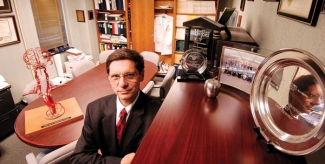by John Bach
They called it the "Lazarus Effect."
One minute, patients couldn't walk or talk. The next, they were regaining both mobility and speech. It was 1987, and for the first time in medical history, victims of acute stroke were responding to treatment. Dead brain cells were seemingly coming back to life.
"We saw people get better from severe deficits that we had never seen before," recalls UC neurologist Joseph Broderick, MD '82, who helped lead the world's first trial of the drug that still remains the only FDA-approved treatment for opening clogged arteries in stroke patients.
"Those were very exciting days," says Broderick, now UC chair of neurology. "To see somebody who can't speak and can't move recover on the table, that's one of the best experiences I can imagine."
He and a handful of UC clinical researchers at University Hospital conducted the breakthrough stroke study in the late '80s using the clot-busting drug called tissue plasminogen activator or tPA. Up until then, tPA had been used successfully by cardiologists to clear blockage, but it only reduced damage to the heart if given within hours of cardiac arrest symptoms.
For their study, the UC team developed a similar trauma model for stroke, the third leading cause of death in the United States. It was a novel approach to a previously untreatable disease that had never been given every-second-counts urgency. In the end, Broderick's trial team discovered that tPA, when injected in a vein within 90 minutes of stroke onset, could seriously reduce or minimize brain damage.
"In the early days, we used a big old cell phone that you plugged into your car lighter, and we'd hand off the cell phone box to the person on-call the next day," says Broderick.

 Issue Archive
Issue Archive